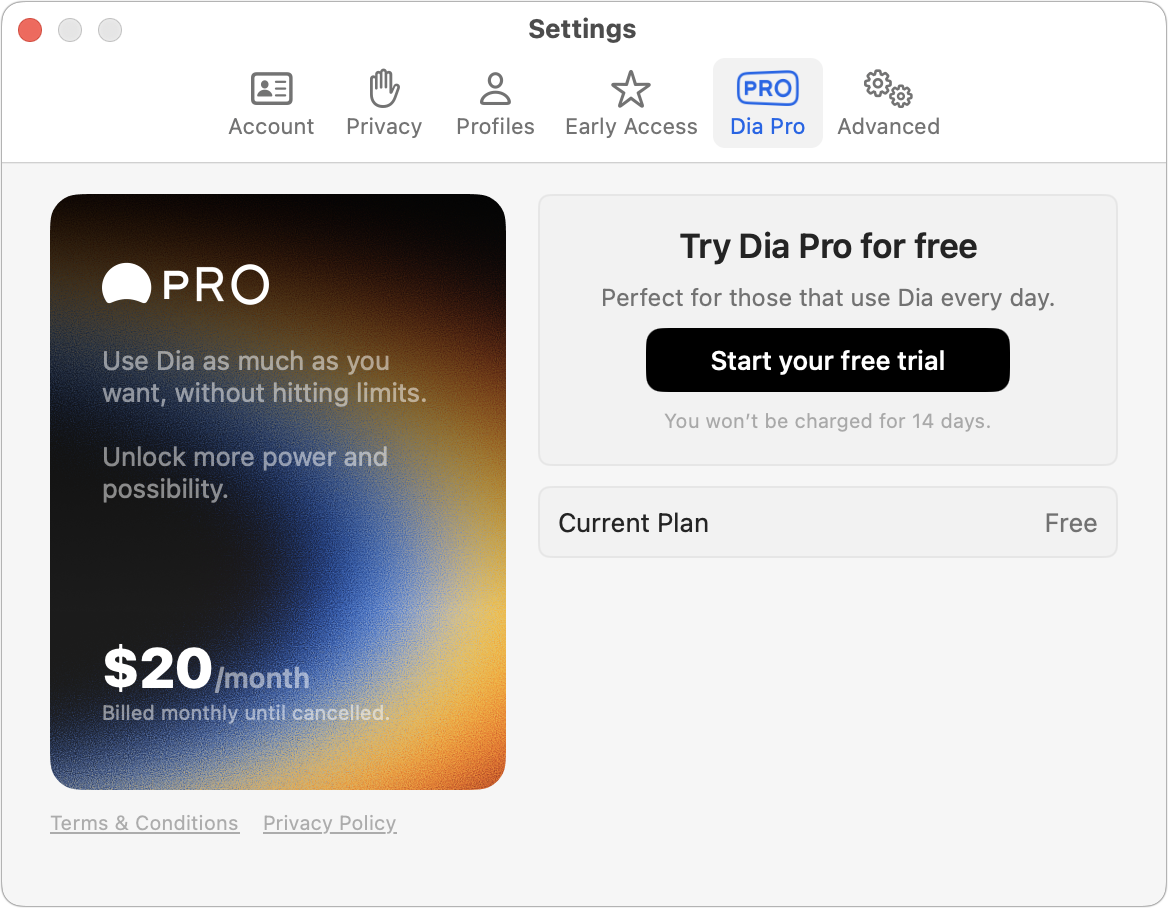Despite refining its Arc Web browser into a must-have for many professionals, The Browser Company never charged for it or even floated a business model. The firm has changed gears with its follow-up browser, Dia. Even though Dia isn’t broadly available and is still in early development (currently version 0.41), it’s now possible to subscribe to Dia Pro for $20 per month with a 14-day free trial. You can download Dia from that page even if you’re not an Arc user or on the waitlist; I don’t know if it will let you set up a new account.
The only difference between Dia and Dia Pro is “Chat as much as you want, without hitting limits.” The Browser Company doesn’t specify what those limits are, although presumably you’ll be informed (and provided with an upsell) once you exceed them. Last month, The Browser Company CEO Josh Miller told the New York Times that it would offer multiple plans ranging from $5 to hundreds of dollars per month, depending on usage, but a free version would remain available for those who use it only a few times a week.
This new subscription model was likely triggered by Dia’s chatbot racking up significant bills from the AI providers it taps for responses to user questions. According to the New York Times article, Dia leverages ChatGPT, Claude, and Gemini, among others, analyzing user prompts and routing each one to whichever AI model is most likely to give the best response.
The problem Dia faces is that it’s far from alone in adding a context-aware chatbot to a Web browser. Microsoft Edge—maybe not your first choice for a Mac browser—offers Copilot in a sidebar and can work with the contents of open tabs. Brave users can turn on the Leo AI sidebar. Subscribers to Google’s AI Pro plan ($19 per month) can access Gemini within Chrome. Perplexity has made early versions of its Comet browser available to Perplexity Max ($200 per month) subscribers and some people from its waitlist. Reuters reports that OpenAI is close to releasing its own browser as well.
I still haven’t found the time or brain space to undertake a comprehensive comparison of Brave, Dia, and Edge, the AI-powered browsers I can use easily. I continue to dabble with Dia, and while I find it interesting to have chatbot conversations around the pages I’m reading, I always go back to Arc for the numerous pinned tabs that give me single-click access to my online life (see “Do You Use It? Revisiting Websites with Windows, Bookmarks, Tabs, and Pinned Tabs,” 11 July 2025).
Frankly, I don’t have high hopes for Dia. As I noted in “Dia Browser Debuts with Contextual AI Chat, But Arc Users Feel Left Behind” (20 June 2025), part of the rationale behind ditching Arc for Dia was that The Browser Company wanted to build a product that could be used by hundreds of millions of people. That may be necessary to satisfy the venture capitalists providing the funding—$128 million so far, according to TechCrunch—but it’s hard to see how the Dia we have today could somehow become enough better than both Chrome and Edge to attract that many users. Arc may have been too much for everyday users, but it could have had a chance at a sustainable business model as a high-powered productivity tool for power users. I’d pay $20 per month in a heartbeat for a version of Arc with Dia’s AI sidebar. Dia itself isn’t nearly compelling enough for that.
